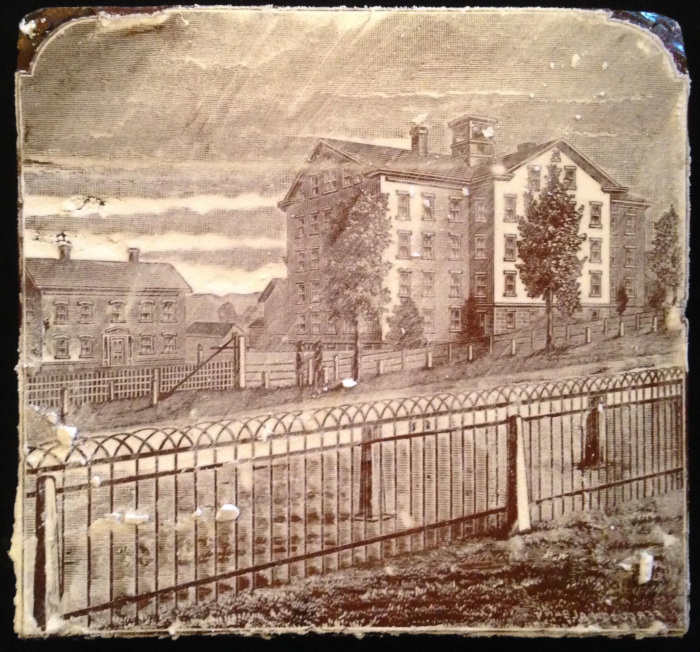
Printing Block of Mount Lebanon Church Family Dwelling House, Hiram Ferguson, Albany, NY, ca. 1883, Shaker Museum | Mount Lebanon, 1957.8469.1
These two printing blocks were made by a process of photo-engraving and, when inked and printed, produce a half-tone image – a printing surface made up of small dots to produce a picture that shows some shading rather than being starkly black and white. The buildings on the blocks – the Mount Lebanon Meetinghouse (1824) and […]

Printing Block of Mount Lebanon Church Family Dwelling House, Hiram Ferguson, Albany, NY, ca. 1883, Shaker Museum | Mount Lebanon, 1957.8469.1

Printing Block of Mount Lebanon Meetinghouse, Hiram Ferguson, Albany, NY, ca. 1883, Shaker Museum | Mount Lebanon, 1957.8469.1
These two printing blocks were made by a process of photo-engraving and, when inked and printed, produce a half-tone image – a printing surface made up of small dots to produce a picture that shows some shading rather than being starkly black and white. The buildings on the blocks – the Mount Lebanon Meetinghouse (1824) and the Church Family Dwelling at Mount Lebanon (1875) – are both still standing. The images are based on photographs; the image of the Meetinghouse is taken from a stereograph produced by James Irving of Troy, New York, sometime prior to 1873 and, while the original photograph on which the image of the Dwelling is based is still unknown to us, it post-dates the building’s completed construction in 1876. The Meetinghouse block was acquired by Shaker Museum | Mount Lebanon in 1957 from materials that had been moved to Hancock Shaker Village when Mount Lebanon closed. The block depicting the Dwelling was purchased in 2009 from an independent dealer who traced its provenance to Eldress Emma B. King at Canterbury, New Hampshire in the 1950s.

Outing: An Illustrated Magazine of Recreation, 2 (June, 1883), p. 1

The Mount Lebanon Meetinghouse as Printed in Outing, 1883, p. 2
Both blocks were used to illustrate the article, “A Quaint and Curious People. A Century of Shaker Life on the Lebanon Hills,” in the June, 1883 issue of Outing: An Illustrated Magazine of Recreation. Outing, published in Boston, Massachusetts, was in its second year of publication and originally focused on bicycling as a popular recreation. In its first year it was published under the title The Wheelman. It is likely the Shakers were offered up as an interesting sightseeing trip as part of a ride over the Lebanon Hills.

Library Stationary, Church Family, Mount Lebanon, NY ca. 1890, Shaker Museum | Mount Lebanon, 1950.4255.2
The article appeared at a time when the Shakers were using similar illustrations of Shaker villages as cover art on their publication, The Manifesto, but neither of these illustrations was ever used in that or any other Shaker publication. It therefore seems likely that the publishers of Outing had the blocks made specifically for the article and may have retained them for a number of years, making it impossible for the Shakers to use the images. It does appear that at some later date the Shakers were able to acquire the blocks because before the end of the century the block illustrating the Dwelling was used on letterhead stationery for the Church Family Library at Mount Lebanon.

Advertisement for Hiram Ferguson from Albany City Directory for 1883
The blocks themselves were made in Albany, New York, by Hiram Ferguson, best known in the Shaker world as the wood engraver who produced the images of Shaker chairs and oval boxes that were used to illustrate any number of Shaker chair catalogs. For the illustrations in the chair catalogs, Ferguson worked from photographs as well, but he used the photographs as the basis for his wood engravings – the art form for which he was best known in the 1870s. To produce multiple copies of the wood engravings so they could be used over years for the publication of the chair catalogues, Ferguson would have had them copied as type-metal blocks – a process that was much cheaper than duplicating the wood engravings. Ferguson’s advertisements in various Albany City Directories in the 1870s promote him as a wood engraver, but by the 1880s he had added “Photo-Electro Plates” and “Electrotyping” to his repertoire.
As an aside to the story of the Shakers and their relationship with Hiram Ferguson, it was noted in the Rochester, New York, Democrat and Chronicle for December 30, 1900, that on the day before “One of the boldest crimes that was ever committed in this city [Albany, NY] and the motive for which is shrouded in mystery, happened to-day when Hiram Ferguson, who is about 75 years of age is suffering from a fractured skull and his recovery is doubtful. The weapon used was a stove shaker, with which the assailant struck Ferguson twice over the ear…. The assailant has thus far eluded the police.”
There is obviously more to be learned about these printing blocks. Anyone knowing about the source for the image of the Dwelling House or additional uses of these images in Shaker or non-Shaker publications, we hope, will be kind enough to share them.